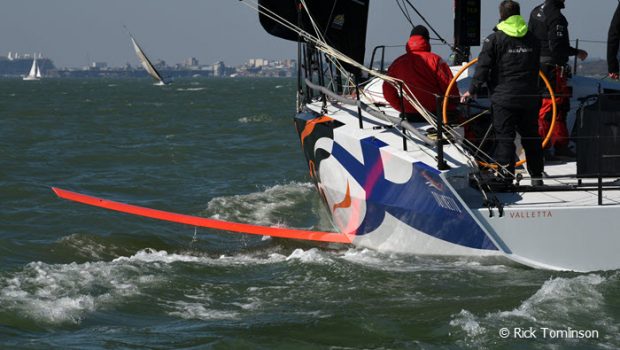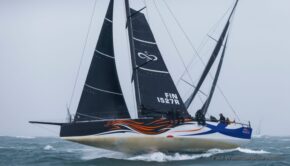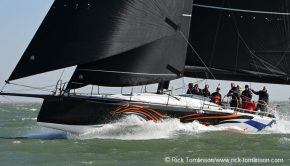Foil assisted high performance 52 footer
Published on March 31st, 2022
There are two facts about rating rules: they all believe they can rate any type of boat, and none of them are most effective unless similar types of boats are gathered to compete. While it is their ego and the openness of the sport that drives the first reality, it then is for race administrators and competitors to manage the ramifications.
These facts come to mind as the first Infiniti 52 undergoes sea trials in the Solent hitting speeds of 28+ knots. Designed by Hugh Welbourn, the Infiniti 52 is the first foil assisted high performance/racing yacht developed for semi-custom production.
As stated by Infiniti Yachts, the Infiniti 52 is unique in several ways. Firstly it is one of the few designed from the outset specifically to be campaigned offshore, rather than inshore windward-leeward racing. But most significantly it is the only 52 fitted with a Dynamic Stability Systems (DSS) retracting lateral foil.
Along with a keel, the DSS foils protrude out the sides of the boat, deployed just beneath the water to leeward, providing ‘righting moment on demand’ and providing more lift the faster boat (and foil) pass through the water, just like adding crew weight to the rail or ballast to the keel. The net result is a significant speed boost.
While the Infiniti 52’s DSS foil isn’t designed to make the boat fly, it does significantly reduce displacement and drag, again increasing speed. And with the foil adding righting moment in ultimate stability conditions, the keel bulb doesn’t need to be as heavy, thereby keeping displacement light, again increasing speed.
The design approach is already on the water with the highly successful Infiniti 46 Maverick which has been class winner in the Rolex Middle Sea Race twice; in the RORC Transatlantic Race; Newport Bermuda Race, and overall winner of the SoCal 300.
Maverick has all the ‘bells and whistles’, including twin ‘flip out’ DSS foils, plus a canting keel and canard. In comparison the 52 is simpler with a single DSS foil sliding laterally across the bottom of the boat within its case.
Comparatively, the 52 has a fixed keel and 600kg water ballast, split into twin tanks each side aft to add grunt upwind. While the canting keel/canard is effective, it comes with complexity and a fixed weight, whereas water ballast can be jettisoned at any time, maintaining light displacement.
The DSS foil is designed to be deployed and then left to do its job, but the water ballast does also permit the boat to be trimmed slightly stern down, which of course adds angle of attack to the foil, increasing its lift.
For upwind angles, while the DSS foil may provide less lift, one of its secondary features comes into play – in addition to reducing heel, the foil also significantly reduces pitching by up to 40%, thereby improving the stability of the wind’s flow over the sails and maintaining driving force, especially when the sea state gets lumpy, improving VMG.
As the TP52 Class has had a highly successful secondary market in offshore races, can the rating rules fairly assess the performance of the Infiniti 52? Standing by.








 We’ll keep your information safe.
We’ll keep your information safe.